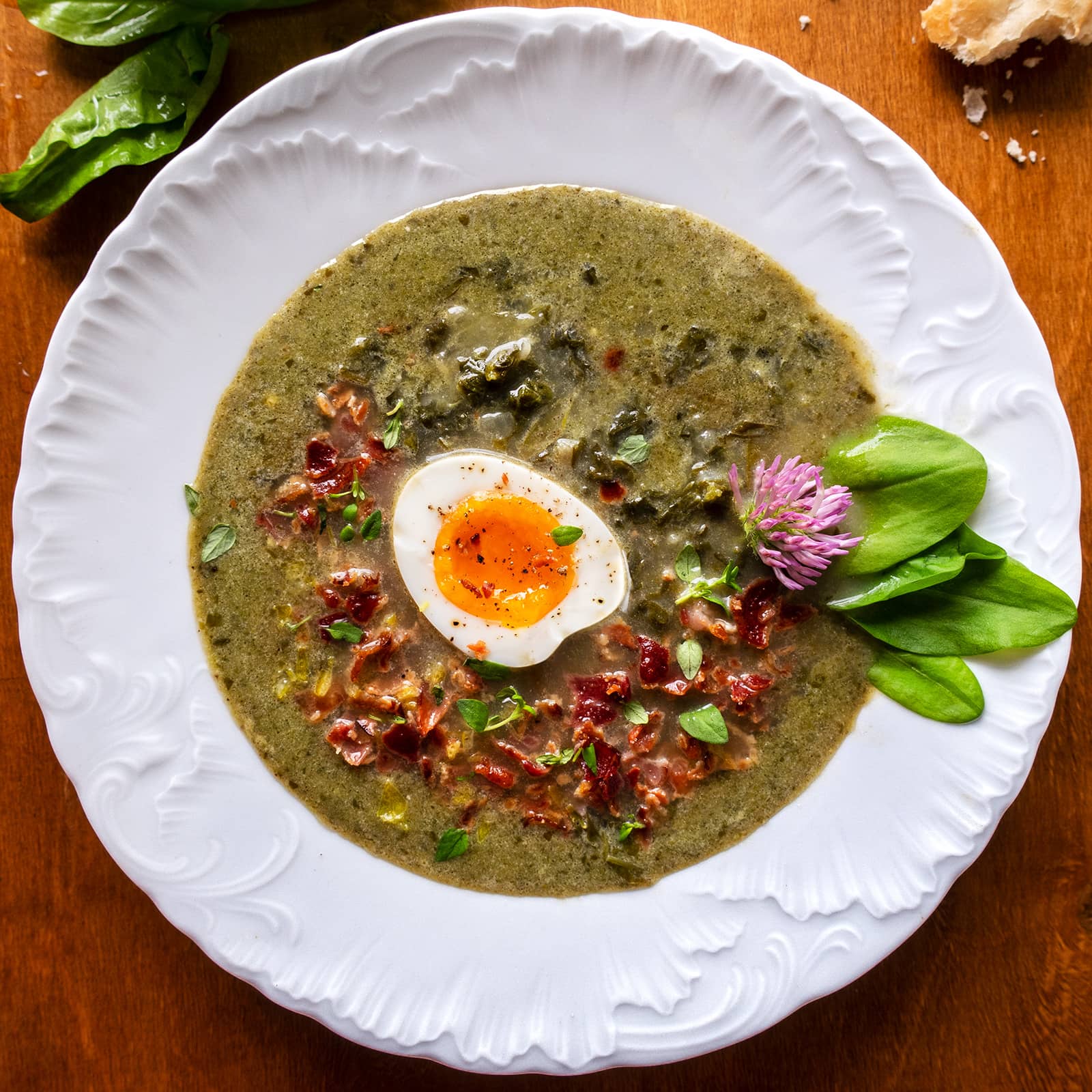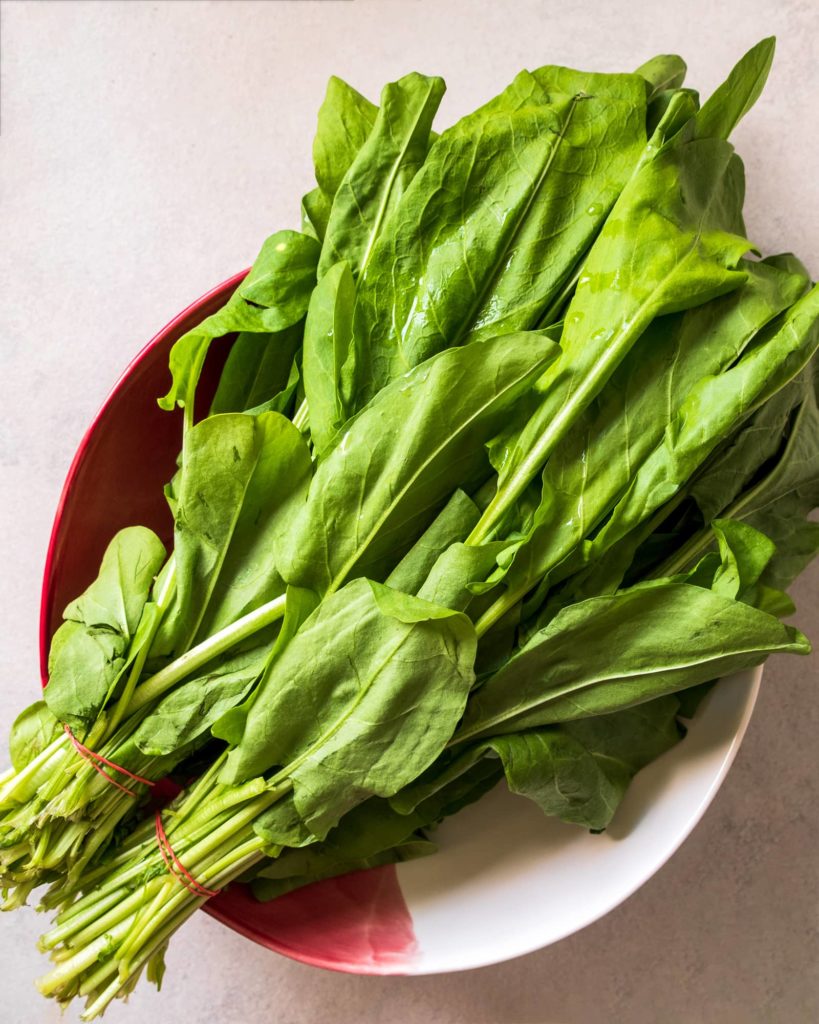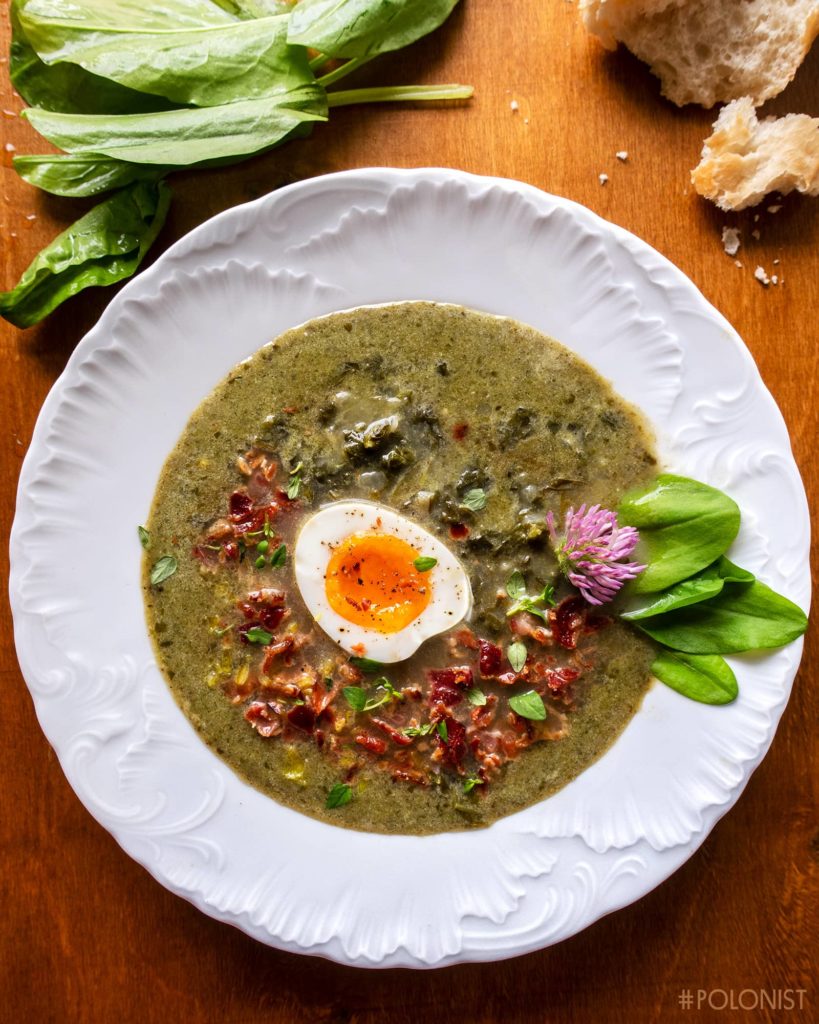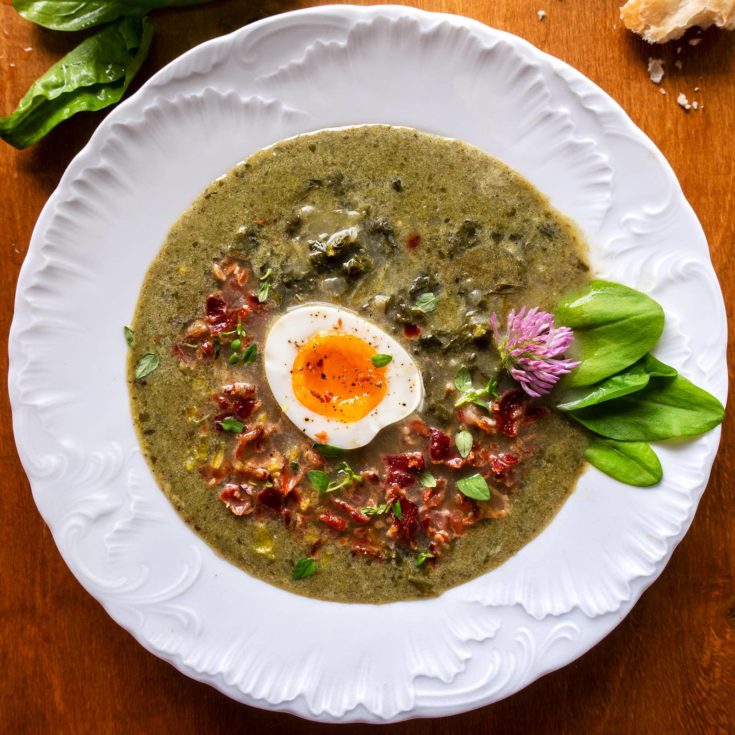Zupa Szczawiowa z Boczkiem i Jajkiem
Szczawiowa: Polish Sorrel Soup
How to pronounce it?
zoo-pah shtchavio-vah
‘Play’ to hear:

With the start of May comes the season for one very quintessentially Polish ingredient: sorrel. Springtime weather favours long walks through the meadows – and if you watch carefully, you’ll find that it grows nearly anywhere. It’s a forager’s dream.
Fresh sorrel leaves have a sour, zingy, slightly piquant flavour. They’re perfect for adding sharpness to those heavier, richer dishes that need more oomph.
A bunch or two can be transformed into one of our all-time favourite soups: Szczawiowa. Served with boiled eggs, potatoes and cream, it’s one of the greatest comfort foods. Sour, intense and filling – it’s the flavour of Polish spring.
For the full list of ingredients & detailed instructions, please see the recipe card at the end of this post. But before you scroll, there’s important stuff to know below.
Do you need any special ingredients or equipment?
Most of the Szczawiowa ingredients should be easily available at any major grocery store. The only troublesome ingredient is also the most important one:
Fresh sorrel leaves
These spear-shaped leaves have a distinctly sour, slightly piquant flavour. In their prime season (from May to early June), they grow on nearly every Polish meadow. Sorrel is also sold in bunches, at greengrocers and at farmer’s markets; but when cultivated, it tends to be milder in flavour.

Internationally, fresh sorrel can be tricky to buy, but there are ways around it:
- Luckily, sorrel grows easily from seed and, as a perennial plant, it will keep on regrowing every year. If you’re into gardening, it’s worth giving it a go.
- Alternatively, you could try using frozen or canned sorrel (typically sold in jars). Try inquiring about it at your local Polish or Eastern European store.
How to serve it?
Szczawiowa can be served either hot or cold, but we recommend the former. It’s most commonly served with one (or more) of the toppings below:
- sour cream (12-18% fat), thick natural yoghurt, crème fraîche or soured milk; either mixed with the soup or added as a dollop in the middle
- egg; usually hard-boiled and halved (or quartered). It complements the soup beautifully. You could also serve it poached or fried.
- mashed potatoes; to make the soup more hearty, some recipes suggest adding a generous spoon of a mash in the centre of the plate
- kiełbasa: a few slices of high-quality sausage greatly improves the overall flavour. If you use raw white kiełbasa, make sure to let it cook for at least 20-30 minutes, until cooked throughout
- fried bacon rashers; they add that extra crunch!
- croutons; again – for crispiness
- pan-fried or roasted potato rounds
- lemon zest; cut into thin strips, for more citrusy notes (and the visual appeal)
- edible flowers
What to serve it with?
Szczawiowa is usually served as an appetizer, right before the main meal.
To make this Polish-style Sorrel Soup a bit more filling, serve it with mashed potatoes (as suggested above), a piece of baguette or a few slices of fresh bread.
Can you make it another way?
Yes. This recipe was inspired by Hanna Szymanderska’s “750 Tradycyjnych Polskich Potraw” (“750 traditional Polish dishes”) cookbook, with small alterations.
The author calls for blending all the leaves – but here we’re leaving around one-fifth of them aside, unblended, returning them to the soup at a later stage. That way the soup’s texture is more varied and multidimensional. But feel free to blend the soup completely.
Other popular recipes make the following suggestions:
- adding different greens, such as nettle, garden orache, chard, dandelions or wild garlic
- keeping the soup clear (without any cream)
- not blending the leaves at all – but leaving them whole.
What diets is it suitable for?
This recipe is suitable for a traditional diet, but it’s also gluten-free.
For a vegan version of this soup:
- use vegetable stock and
- replace butter with plant-based oil
- replace cream with coconut milk (or another plant-based cream) and…
- skip the bacon & egg and top the soup with seeds and vegan croutons instead.
How long can you keep it in the fridge?
Once you’ve served Szczawiowa, don’t keep it out for longer than 3-4 hours at room temperature.
If you would like to store any leftovers, let them cool first. Next, move them into a container covered with a lid. Aim to consume within the next 3 days.
Can I freeze it?
Yes, you can, but just the soup itself, without the eggs. Freeze any leftovers in a freezer-friendly container with a lid, as soon as they’re cold enough to do so.
Don’t forget to label the box with a description and the date. Aim to consume within 3 months.
How do I reheat it?
From chilled
Move the soup into a microwavable container and cover it with a loosely fitting lid. Heat for 4-7 minutes, until piping hot throughout.
Alternatively, reheat it on the stove. Bring the soup into a near-boil, reduce to a simmer, and cook for another 2-3 minutes.
From frozen
Leave to thaw overnight in the fridge. Reheat in the microwave (covered) for 3-5 minutes; then stir. Cook for a further 5 minutes until piping hot.

Recipe: step by step
Szczawiowa: Polish Sorrel Soup with Fried Bacon Flakes and Soft-Boiled Egg

Ingredients
Soup
- 34 fl oz (1 litre) homemade broth; can replace with stock (meat or vegetable-based), see notes
- 2 bunches (≈ 14 oz, 400 g) fresh sorrel leaves
- 0.5 bunch (≈ 4 oz, 120 g) fresh nettle leaves; can replace with baby spinach
- 1 medium onion (≈ 5 oz, 140 g)
- 1.5 tablespoon butter
- 0.5 teaspoon salt
- 1 teaspoon lemon juice
- pinch of black pepper
- 1 teaspoon sugar, can replace with mild honey
- 6 tablespoons (≈ 3.5 fl oz, 100 ml) of sour cream; 12-18% fat
Garnish (optional)
- 4 medium eggs; poached, fried, hard- or soft-boiled
- 2 teaspoon of lemon zest; grated or cut into strips
- 1 tablespoon fresh thyme
- 4 bacon rashers; fried and crushed
Instructions
Prep work
- Wash all leaves, pat them dry and chop them roughly.
- Peel onion, dice it finely.
Cooking
- In a heavy-bottomed stock pot, melt butter. Add diced onion and sauté over medium heat for 5 minutes, until lightly golden.
- Add chopped leaves with a pinch of salt, combine with a spatula. Stew under a lid for around 3-5 minutes.
- Pour broth in, stir and bring to a near-boil. Reduce the heat (so that the soup just simmers), cover with a lid and cook for 10 minutes.
Blending
- [Optional] Using a slotted spoon, remove around one-fifth of the leaves and into a bowl. Set aside.
- Blend soup with immersion blender until smooth. Alternatively, if using a food processor, allow the soup to cool down first, then move it over to the device's container, blend until smooth and return to the pot.
- [Optional] If you removed one-fifth of the leaves, now it's the moment to return them to the pot.
Finishing touches
- Add 0.5 teaspoon of salt, 1 teaspoon of lemon juice, a pinch of ground pepper and 1 teaspoon of sugar. Stir and have a taste. Is it too sour for your liking? Add a touch of sugar. Is it not sour enough? Add more lemon juice.
- Bring the soup to desired temperature. Add cream and stir.
- Pour into individual bowls or soup plates. Garnish with eggs, lemon zest, fresh thyme and fried & crushed bacon. Serve immediately.
Notes
- It's best to use a rich, homemade meat & vegetable broth. In our case, we used duck, beef, włoszczyzna, all-spice berries and lovage and turned it into a thick, gelatinous broth.
- This recipe adapted from "750 Tradycyjnych Polskich Potraw" cookbook by Hanna Szymanderska (page 37)
Nutrition Information:
Yield:
4Serving Size:
1Amount Per Serving: Calories: 656Total Fat: 28gSaturated Fat: 9gTrans Fat: 0gUnsaturated Fat: 16gCholesterol: 173mgSodium: 2378mgCarbohydrates: 56gFiber: 1gSugar: 27gProtein: 42g
Polonist is reader-supported. When you buy through links on our site, we may earn a small affiliate commission. Learn more
Recipe Information
Filed under:
Alternative traditional/regional names:
Szczawianka, Barszcz Szczawiowy
Also known / Misspelt internationally as:
Polish Sorrel Soup, Sorrel Borscht, Green Borscht
Tested by:
First published on:
Recipe by / Adapted from:
This recipe was inspired by Hanna Szymanderska’s “750 Tradycyjnych Polskich Potraw” (“750 traditional Polish dishes”) cookbook, with small alterations.
Story by:
Bibliography / References: